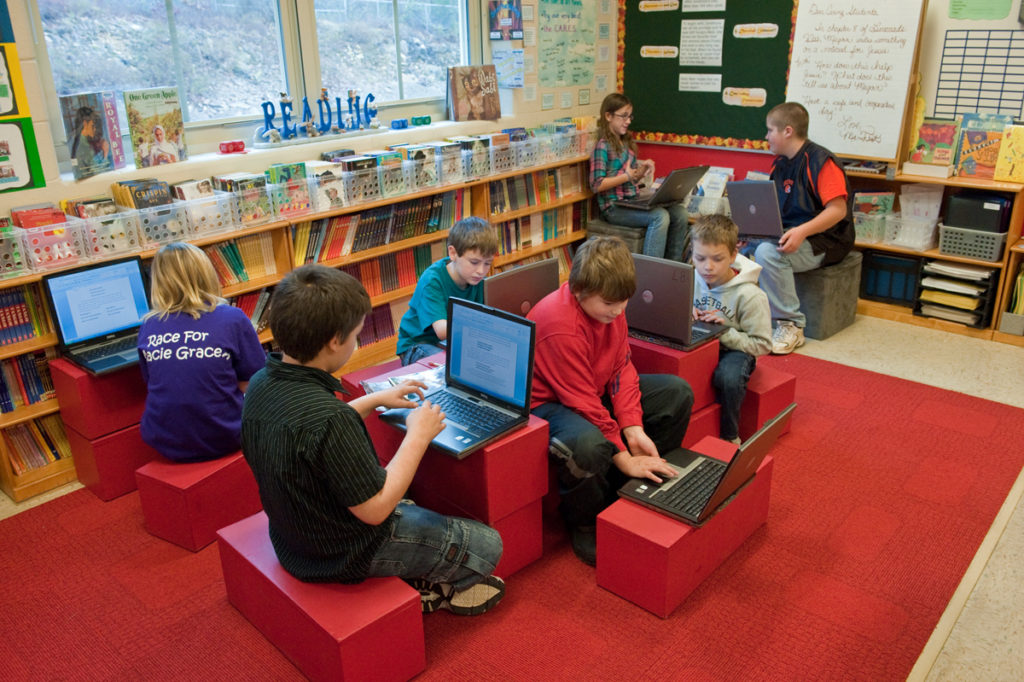
School’s over! As you clean tabletops, take down anchor charts, and sort supplies, pause and take a look around your classroom. Will you be leaving a space that worked well for most of the year’s learning activities, a space you happily anticipate returning to in the fall? Or did the room seem to somehow get in the way of your teaching and students’ learning?
Students spend more time in classrooms than in any other part of the school, so the way these spaces look, feel, and function has a huge impact on how comfortably—and how much—they learn. With the past year fresh in your mind, now is a good time to reflect on what makes any classroom a great space for learning, how well your own classroom worked this year, and what you might do to make it work better.
Furniture that fits students’ bodies; materials that suit their developmental capabilities, interests, and learning styles; uncluttered areas where they can work alone or with classmates; displays that reflect their work and ideas—these are the building blocks of a space that welcomes children and supports their learning.
Such student-centered spaces entice children to:
Although most of us don’t choose the classrooms we teach in, we usually do have a measure of control over how we equip and arrange them. The checklists that follow will help you zero in on elements you might want to add or change to make your own classroom more welcoming and learning-friendly.
Organized With Children in Mind: Classroom Snapshots
There’s no magic formula for creating a well-organized classroom. That’s because what works well depends on students’ capabilities and needs, the space you have to work with, and your vision for how learning should look, sound, and feel. And what feels like a perfect fit one year may feel less so the next as you respond to changes in curriculum and adjust your teaching practices for each new class of students.
That said, though, these checklists do include important elements to consider as you organize your classroom space to welcome all children and support their best learning. You can use one or more of the checklists to zero in on aspects of classroom organization you’d like to improve. Choose the reflection time that works best for you: as you close out the school year; during the summer, when you can think and plan at a more leisurely pace; or at the end of the summer when you’re preparing the space for a new group of students.
Does the classroom have spaces for:
__ Partner work
__ Small-group work
__ Whole-group circles in which everyone can see and be seen
__ Messy work
__ Quiet, independent work
__ Relaxing work (spots where children can lie down or sit on the floor to read, do math, or draw)
Furniture
Are tables, chairs, bookcases, cubbies, etc.:
— Sized properly for children
— Comfortable
— Suitable for children with special needs
— Clean and in good repair
— Appropriate for multiple uses throughout the day
— Easy for children to move into different learning configurations (be sure to teach children how to move furniture safely)
— Arranged to:
Do You Really Need a Teacher Desk?
Often the teacher’s desk is the largest piece of furniture in a classroom. It’s also often the least used—except as a repository for items we haven’t had time to put away! If your desk takes up too much space, consider replacing it with a smaller, easily moveable table that has multiple uses.
Before moving your desk out, make sure you have a filing cabinet or bin and one or two “Teacher Only” shelves where you can store the stuff that formerly lived on and in your desk.
Materials
Are materials:
__ Relevant to children’s work and appropriate for their age
__ Clean and in good working order, with all parts present
__ Easily accessible if children use them independently
__ Inaccessible if children do not use them independently
__ Sorted and stored in bins or boxes or on shelves
__ Kept near the workplace where they’ll be used
__ Clearly labeled with words, graphics, or both
Displays
Do displays:
__ Consist mostly of children’s work (vs. commercial products or your creations)
__ Include students’ names and portraits (photos or drawings)
__ Reflect students’ age, interests, and current work (edit displays regularly to keep them fresh and relevant)
__ Hang at children’s eye level
__ Include work from all students
__ Focus on process (consist of both drafts and polished work)
__ Show class as well as individual work (classwork might include rules, learning goals, and favorite songs, activities, or greetings)
Positive Time-Out Spaces
Are the time-out spaces (at least two, if possible):
__ Used for no other purpose
__ Away from the action but placed so the child can see and hear classmates
__ Within your view from any point in the classroom
__ Supplied with items that can help children calm themselves (a comfortable chair or pillow; a small basket of calming aids such as stress balls or puzzles; a student-generated list of helpful hints for regaining self-control; a poster, photo, or student’s drawing of a peaceful scene)
A well-organized classroom sends a clear and positive message to students: This room was created for you, with your specific needs in mind, because you and your learning are important. With good organization, any classroom, even one that’s small or oddly shaped, can feel comfortable and functional. Without it, even a generously sized room can diminish students’ sense of ease and autonomy and limit their learning.
As you reflect on ways to improve your classroom’s organization, keep in mind that you needn’t change everything at once; just one or two small, simple adjustments can have dramatic effects. So have fun choosing one or two checklist items to work with. See how they affect students’ learning. You’ll likely be so pleased with the results that you’ll soon be ready to try a few more.